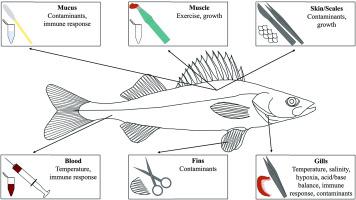Comparative Biochemistry and Physiology B: Biochemistry & Molecular Biology ( IF 2.2 ) Pub Date : 2021-05-28 , DOI: 10.1016/j.cbpb.2021.110629 Ken M Jeffries 1 , Amy Teffer 2 , Sonya Michaleski 1 , Nicholas J Bernier 3 , Daniel D Heath 4 , Kristina M Miller 5

|
Fishes respond to different abiotic and biotic stressors through changes in gene expression as a part of an integrated physiological response. Transcriptomics approaches have been used to quantify gene expression patterns as a reductionist approach to understand responses to environmental stressors in animal physiology and have become more commonly used to study wild fishes. We argue that non-lethal sampling for transcriptomics should become the norm for assessing the physiological status of wild fishes, especially when there are conservation implications. Processes at the level of the transcriptome provide a “snapshot” of the cellular conditions at a given time; however, by using a non-lethal sampling protocol, researchers can connect the transcriptome profile with fitness-relevant ecological endpoints such as reproduction, movement patterns and survival. Furthermore, telemetry is a widely used approach in fisheries to understand movement patterns in the wild, and when combined with transcriptional profiling, provides arguably the most powerful use of non-lethal sampling for transcriptomics in wild fishes. In this review, we discuss the different tissues that can be successfully incorporated into non-lethal sampling strategies, which is particularly useful in the context of the emerging field of conservation transcriptomics. We briefly describe different methods for transcriptional profiling in fishes from high-throughput qPCR to whole transcriptome approaches. Further, we discuss strategies and the limitations of using transcriptomics for non-lethally studying fishes. Lastly, as ‘omics’ technology continues to advance, transcriptomics paired with different omics approaches to study wild fishes will provide insight into the factors that regulate phenotypic variation and the physiological responses to changing environmental conditions in the future.
中文翻译:

使用非致死性采样进行转录组学评估野生鱼类的生理状态
作为综合生理反应的一部分,鱼类通过基因表达的变化对不同的非生物和生物压力因素作出反应。转录组学方法已被用于量化基因表达模式,作为了解动物生理学中对环境压力因素的反应的还原论方法,并且已更常用于研究野生鱼类。我们认为转录组学的非致命采样应该成为评估野生鱼类生理状态的规范,尤其是在有保护意义的情况下。转录组水平的过程提供给定时间细胞状况的“快照”;然而,通过使用非致死性采样协议,研究人员可以将转录组谱与适应度相关的生态终点(如繁殖、运动模式和生存。此外,遥测是渔业中一种广泛使用的方法,用于了解野生动物的运动模式,当与转录分析相结合时,可以说是野生鱼类转录组学非致命采样的最强大用途。在这篇综述中,我们讨论了可以成功纳入非致死性采样策略的不同组织,这在新兴的保护转录组学领域特别有用。我们简要描述了从高通量 qPCR 到全转录组方法的鱼类转录分析的不同方法。此外,我们讨论了使用转录组学进行非致命性研究鱼类的策略和局限性。最后,随着“组学”技术的不断进步,


























 京公网安备 11010802027423号
京公网安备 11010802027423号